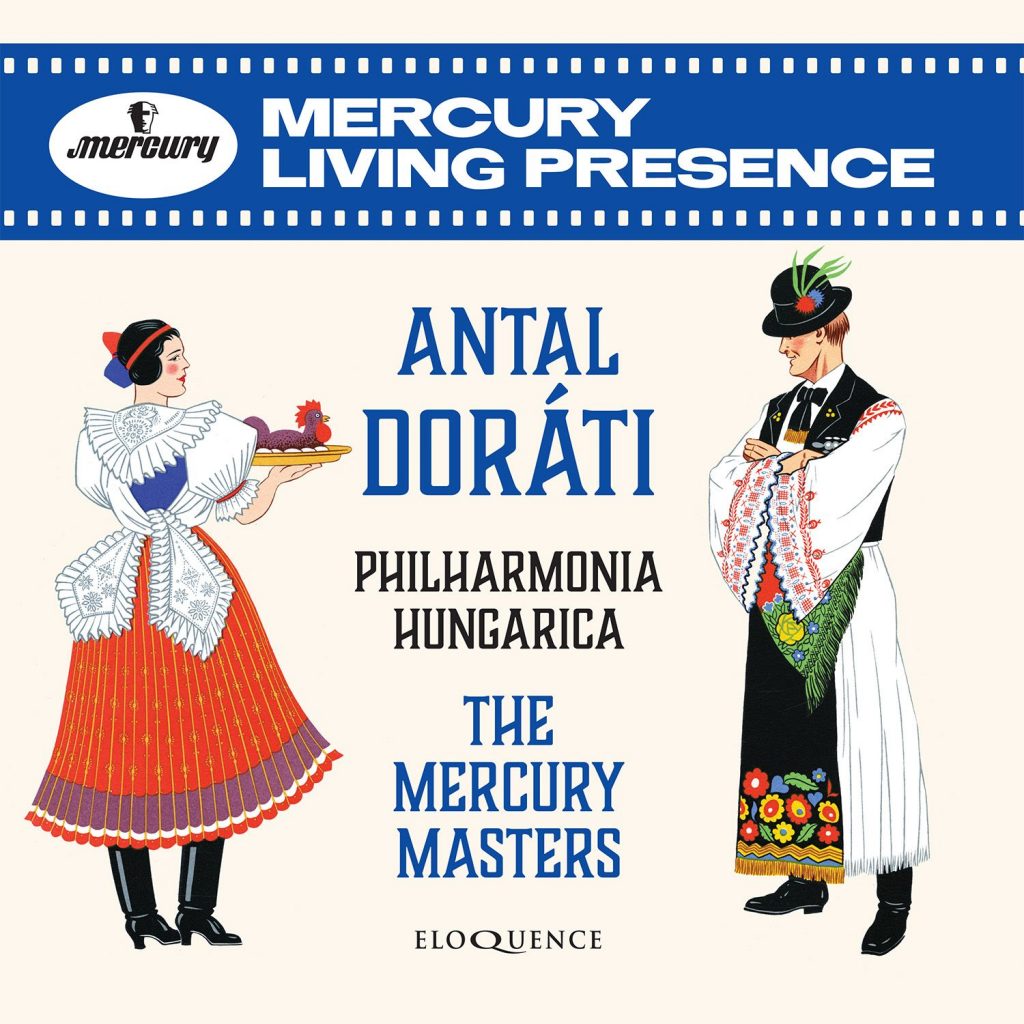


Founded in 1956, the Philharmonia Hungarica emerged from turbulent post-war times as a crack ensemble of émigré Hungarian musicians who had fled Communism for the West. While they gave concerts in Europe and the US, it was through these seven albums on Mercury and Philips that they became famous, and synonymous with the name of the conductor Antal Doráti.
Together, Doráti and the Philharmonia Hungarica would go on to make a celebrated cycle of Haydn symphonies for Decca in the early 1970s. But these early recordings already demonstrate what a potent artistic combination they were, as forerunners both to that monument of gramophone history, and to the modern-day Budapest Festival Orchestra. As reviewers at the time remarked, the strings play with a particular unanimity and attack which sounds uniquely ‘Hungarian’.
A booklet essay by the music historian David Patmore tells the story of the Philharmonia Hungarica and their debut on record. All six Mercury albums were recorded at sessions in June 1958, held in the Vienna Konzerthaus: a spacious but analytical acoustic, well suited to the label’s trademark high-impact sound.
The repertoire played to the strengths of both label and musicians: mostly Hungarian music from the last half century, vividly coloured and coursing with rhythmic energy. There is an early taste of the ensemble’s feeling for Haydn, in the ‘Surprise’ and ‘Drum Roll’ Symphonies. Doráti’s established reputation as a masterful conductor of ballet brings a sweeping sense of line to a collection of Viennese waltzes. The ace in the pack of the Mercury/Philharmonia Hungarica albums was Respighi’s suites of Ancient Airs and Dances, which soon became a demonstration disc for audiophiles worldwide.
Never previously collected together, this Mercury legacy is complemented by the two albums which the Philharmonia Hungarica and Doráti recorded for Philips. The ensemble’s first-ever recording, made in October 1957, appeared on the Fontana imprint, coupling Bartók’s Divertimento with Leo Weiner’s Hungarian Dances. From 1974, the second Philips album returns to Bartók, with gripping interpretations of the Music for Strings, Percussion and Celesta and Dance Suite.
CD 1 MUSICA HUNGARICA
KODÁLY Dances of Marosszék*; Dances of Galánta
BARTÓK–WEINER Two Romanian Dances
*FIRST RELEASE ON CD
CD 2
BARTÓK Dance Suite; Two Portraits
Mikrokosmos (arr. Szerly)
CD 3 WIENERWALZER PAPRIKA
Lehár ∙ Kálmán · Josef Strauss
Dohnányi · Waldteufel ∙ Lanner
CD 4
RESPIGHI Ancient Airs and Dances
CD 5
TCHAIKOVSKY Serenade for Strings
ARENSKY Variations on a Theme by Tchaikovsky
CD 6
HAYDN Symphonies Nos. 103 & 94
CD 7
BARTÓK Divertimento for Strings*
WEINER Hungarian Folk Dances
*FIRST RELEASE ON CD
CD 8
BARTÓK Music for Strings, Percussion and Celesta; Dance Suite
PHILHARMONIA HUNGARICA
ANTAL DORÁTI
“This disc seems to grow more exciting with each groove … The Bartok dances … are whipped up to incandescent heat in this remarkable interpretation.” High Fidelity, October 1959 (Bartók, Kodály)
“Doráti has obviously drilled the orchestra long and hard: they play with fine tone and excellently precise ensemble.” Stereo Review, December 1959 (Respighi: Ancient Airs and Dances)
“Although excellence marks the whole of this refugee Hungarian ensemble, its strings make a particularly sensuous effect in these tastefully dressed-up versions of old lute pieces. Doráti seems to have a real affinity for them, informing the lovely music with gaiety, vigour, or tenderness as the mood demands.” High Fidelity, December 1959 (Respighi: Ancient Airs and Dances)
“Doráti’s orchestra shows great vitality … The strings in particular are splendid, with lovely singing tone in the Divertimento and great virtuosity in the Scherzo of the Weiner suite.” Gramophone, February 1959 (Bartók/Weiner)
“If you like old music tastefully renovated, beautifully played and magnificently recorded, this is the record for you … It really is very fine indeed.” Gramophone, April 1960 (Respighi: Ancient Airs and Dances)
“I very much enjoyed Doráti’s way with these seven well-contrasted short pieces … The playing of the Philharmonia Hungarica is strong and colourful, and excellently recorded.” Gramophone, June 1960 (Bartók/Kodály)
“Abounding verve … spiced in Hungarian style.” High Fidelity, September 1960 (‘Wienerwalzer Paprika’)
“Doráti’s performance is very expressive… A most attractive record.” Gramophone, July 1960 (Arensky, Tchaikovsky)
“Doráti is quite superb in his individual shaping of these delightful waltzes.” Gramophone, December 1960 (‘Wienerwalzer Paprika’)
“The precision of the playing is outstanding, and the individual instrumental contributions are beautifully realized.” Stereo Review, July 1965 (Haydn: Symphony No. 94)
“Doráti achieves colourful performances, full of vigour and vitality. The Dance Suite has all the requisite thrust and rhythmic definition.” High Fidelity, September 1971 (Bartók)
“A very clean, forthright presentation by a superior group of strings.” High Fidelity, January 1964 (Bartók, Weiner)
“It is virtually inconceivable that anyone could match Doráti’s realization of these scores.” Stereo Review, February 1974 (Respighi: Ancient Airs and Dances)



